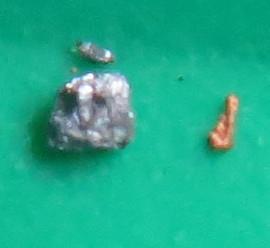- Joined
- Sep 25, 2013
- Messages
- 241
- Reaction score
- 127
So I have been crushing some rock which contains a few small pickers, after panning the crushed rock and removing the black sand and also the dolly pot steel with a magnet I was left with the following.


I dont have much experience with normal black sand because I've not found a heap of it in the creek where I found the rock I've just crushed, is this just normal black sand which has gone a bit silver like because I've crushed it, or something else?
Interestingly apart from the two pickers which fell out of the rock before I crushed it there does not seem to be other gold in the rock.
Photos were taken through a 30x loupe.


I dont have much experience with normal black sand because I've not found a heap of it in the creek where I found the rock I've just crushed, is this just normal black sand which has gone a bit silver like because I've crushed it, or something else?
Interestingly apart from the two pickers which fell out of the rock before I crushed it there does not seem to be other gold in the rock.
Photos were taken through a 30x loupe.




